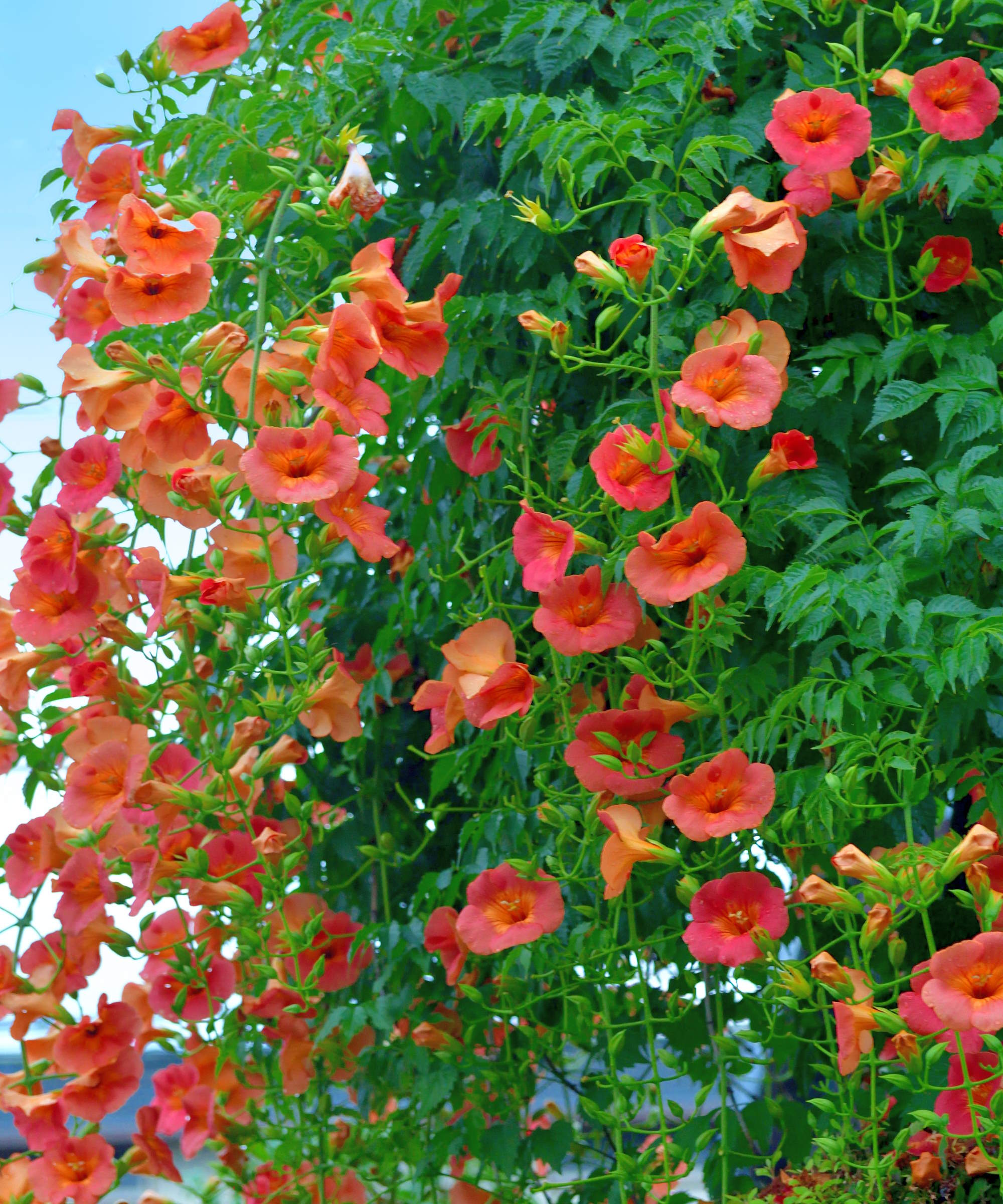When and how to prune a trumpet vine – to keep these vigorous climbers under control
Annually pruning established trumpet vines need not be intimidating, thanks to our expert trimming tips


Trumpet vines, also known commonly as Campsis, are vigorous vines that dazzle with bright orange and red trumpet-shaped flowers from midsummer through into fall.
They are fast-growing climbing plants that are native plants to the United States and do require regular pruning to keep them well-maintained and performing at their finest. A failure to trim regularly can lead to plants getting out of control and even damaging fences, decks, or structures due to their aggressive growth habit.
Despite the importance of the pruning sounding potentially daunting, it can be relatively simple to complete and trumpet vines can even be pruned aggressively without killing them. To help you feel confident about pruning a trumpet vine in your backyard, we take a closer look at when and how to trim and get some tips from plant experts.

Trumpet vines can grow up to 30 feet in a year - making pruning an essential task
Is pruning a trumpet vine important?
Pruning trumpet vines can help you to control the size of the vines and prevent them spreading unchecked and in unwanted directions. Trimming annually will also have advantages in encouraging prolific flowering and maintaining the overall health of the flowering climber.
Best time to prune a trumpet vine

Trumpet flowers can bloom from spring through to fall, depending on the variety
Pruning is an important part of maintaining and controlling a trumpet vine, and you do need to head out to trim at the right time of year. So, to avoid making any pruning mistakes, you may wonder, when should I cut back my trumpet vine?
The fast-growing flowering vine does bloom on new growth that is produced in that current season and the trimming can take place at any stage after the plant has finished flowering in fall. However, just like with lots of other deciduous woody plants, the best time to prune comes in late winter or early spring, depending on your climate and US hardiness zone.
The best time will be just before the new growth emerges for the season ahead, though it is important to schedule the pruning after the risk of frosts has ended for your climate - so the frosts do not penetrate the cuts and risk the health of your trumpet vine.
Design expertise in your inbox – from inspiring decorating ideas and beautiful celebrity homes to practical gardening advice and shopping round-ups.
Pruning during dormancy does help you be able to see the shape of the plant and make informed pruning decisions. The lack of foliage also makes it easier to access all the branches you are going to prune.
While the ideal time to prune a trumpet vine is in late winter or early spring, you can remove any dead, diseased, damaged, or weak branches from the vine at any time without risking its overall health.
Tools for pruning a trumpet vine
When you are planning to prune a trumpet vine, it should only involve a few basic garden tools. This will include a pair of pruning shears and also loppers to remove older vines. Make sure that any garden tools are clean and sharp, to make clean cuts that are easier to heal and also prevent spreading diseases around the garden.
Amy Enfield, senior horticulturist at ScottsMiracle-Gro, also advises ‘wearing gloves and long sleeves is recommended to protect yourself from the plant’s sap, which can cause skin irritation in some individuals’.

Amy has over 25 years of experience in the Lawn & Garden industry and has been with ScottsMiracle-Gro for 11 years. She has a BS and MS in Horticulture from Michigan State University and a PhD in Plant & Environmental Sciences from Clemson University.
How to prune a trumpet vine

Trumpet vines can be pruned back hard and will regrow
Trumpet vines are rapid climbing plants that are popular additions to cover a wall or cover a fence as part of people’s backyard ideas. The vines are commonly trained to climb a trellis, arbour, or framework of wires, and it can take a few years for a newly-planted trumpet vine to establish its strong skeleton of branches. The annual pruning starts once the vine is established after two or three years.
‘The key to keeping a trumpet vine in check starts the year after planting by allowing only a few strong vines to establish and removing the rest by cutting them off at the base of the plant,’ says Amy Enfield. ‘Once the vine is established, which can take a few growing seasons, then pruning becomes annual maintenance.
‘Annual pruning involves pruning the lateral branches coming off the main, established vines. In late winter/early spring they should be pruned back to 2-3 buds.’
Trumpet vines can tolerate heavy pruning, if they are overgrown or just need a rejuvenation. This kind of aggressive pruning can be used to keep the vigorous plant in check and even keep them suitable for small backyards.
When it comes to pruning the plants back hard, Janet Loughrey of Garden Design recommends: ‘To rejuvenate mature plants, cut back all growth to 12 inches above the ground. New shoots will sprout from the main trunk.’
After being pruned hard, the trumpet vine will sprout new shoots from the base, of which two or three of the strongest branches need to be kept and trained while the others are trimmed completely away. Trumpet vines are also notorious for sending out suckers at ground level that are best removed each year.

Janet Loughrey has been a full-time garden photographer and writer for 25 years. She lives and gardens in Portland, Oregon. Previously, Janet gardened in the Adirondack region of upstate New York where she grew up. Experiencing different climates has given Janet a greater appreciation of the gardening challenges they present.
FAQs
Can I prune a trumpet vine in summer?
Pruning a trumpet vine in summer is not ideal, as the vine is going to be in flower and pruning will remove this season’s growth on which the plants bloom. You want to trim in late winter or early spring before the growth starts for the year, or in fall after the vine has finished blooming. The only reasons to trim in summer will be to remove dead, damaged, or diseased wood as you spot it and to deadhead flowers to stop the plant spreading around your backyard.
Hopefully now you have a good understanding of when and how to prune a trumpet vine so you can add it to your gardening checklist for late winter or early spring, as it is a plant to prune in February or March.

Drew has worked as a writer since 2008 and was also a professional gardener for many years. As a trained horticulturist, he worked in prestigious historic gardens, including Hanbury Hall and the world-famous Hidcote Manor Garden. He also spent time as a specialist kitchen gardener at Soho Farmhouse and Netherby Hall, where he grew vegetables, fruit, herbs, and cut flowers for restaurants. Drew has written for numerous print and online publications and is an allotment holder and garden blogger. He is shortlisted for the Digital Gardening Writer of the Year at the 2025 Garden Media Guild Awards.


